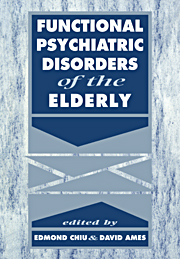Book contents
- Frontmatter
- Contents
- List of contributors
- Preface
- Introduction – A personal note
- Acknowledgement
- Part 1 Classification
- Part 2 General epidemiology
- Part 3 Neuroses
- Part 4 Affective disorders
- Part 5 Psychosexual disorders
- Part 6 Substance use and abuse
- Part 7 Schizophrenia and related psychoses
- Part 8 Psychological, biological and medical issues
- Part 9 Treatment methods
- 25 Geriatric psychopharmacology
- 26 Electroconvulsive therapy in later life
- 27 Family therapy
- 28 Group therapy in the elderly
- 29 Integrated psychotherapy of the elderly
- 30 Management of the treatment team in a multidisciplinary framework
- 31 Occupational therapy
- 32 Nursing management
- 33 Social work and the psychiatry of late life
- 34 Music therapy
- 35 Physiotherapy
- Part 10 Conclusion
- Index
35 - Physiotherapy
from Part 9 - Treatment methods
Published online by Cambridge University Press: 13 November 2009
- Frontmatter
- Contents
- List of contributors
- Preface
- Introduction – A personal note
- Acknowledgement
- Part 1 Classification
- Part 2 General epidemiology
- Part 3 Neuroses
- Part 4 Affective disorders
- Part 5 Psychosexual disorders
- Part 6 Substance use and abuse
- Part 7 Schizophrenia and related psychoses
- Part 8 Psychological, biological and medical issues
- Part 9 Treatment methods
- 25 Geriatric psychopharmacology
- 26 Electroconvulsive therapy in later life
- 27 Family therapy
- 28 Group therapy in the elderly
- 29 Integrated psychotherapy of the elderly
- 30 Management of the treatment team in a multidisciplinary framework
- 31 Occupational therapy
- 32 Nursing management
- 33 Social work and the psychiatry of late life
- 34 Music therapy
- 35 Physiotherapy
- Part 10 Conclusion
- Index
Summary
Introduction
The physiotherapist has a range of responsibilities in functional psychiatric disorders. In addition to treating the physical conditions encountered in an aging population and those more specific to this group of patients, the physiotherapist is responsible for the education of patients, their family, carers and fellow staff members. As a member of the multidisciplinary team, the physiotherapist contributes a sophisticated understanding of normal and abnormal movement and the means of therapeutic intervention for movement problems to the treatment program.
Role of the physiotherapist
In the management of all psychiatric disorders a mature approach is required to assist patients with lack of motivation, cognitive problems and a variety of functional deficits. Physiotherapists undertaking the management of patients with functional psychiatric disorders should possess comprehensive knowledge and skills in cardiothoracic, neurological and musculoskeletal physiotherapy and in techniques of behavioral management. They must understand the normal psychophysiology of aging and the effects of superimposed pathology.
Patients are seen in the context of all the factors impinging on their lives and all health professionals should be aware of the integration between mind and body. Moon (1988) argues that the increasing knowledge in mental health should be absorbed into physiotherapy so that ‘all treatment approaches acknowledge the intrinsic unity between the mind and the body’. This is supported by Katona (1991) who reports that depression is found more often in the elderly with poor physical health than in the physically healthy.
- Type
- Chapter
- Information
- Functional Psychiatric Disorders of the Elderly , pp. 594 - 602Publisher: Cambridge University PressPrint publication year: 1994



